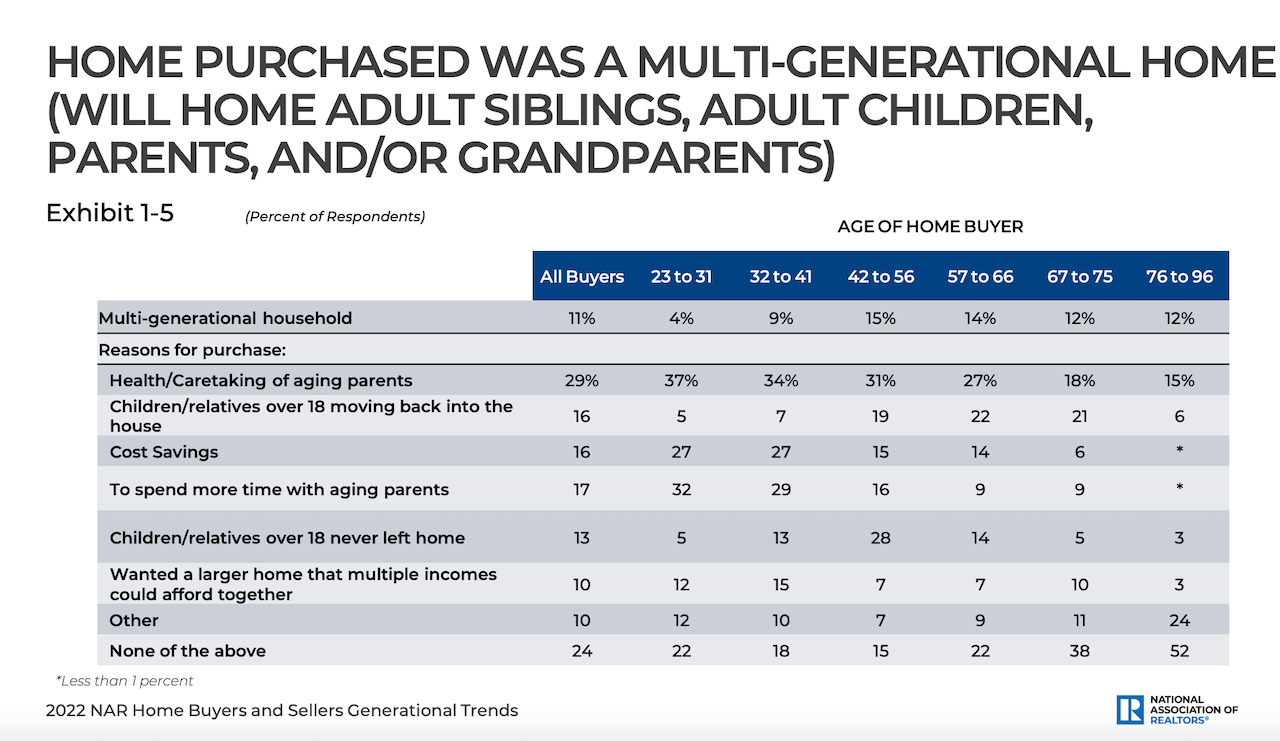Marketing & Sales
Multigen Homes: Where New Normal Necessity Meets Desire
Multigenerational living "for financial reasons" and the evolving trends around extended-family caregiving signal a new hybrid for architecture, engineering, building, and community to tackle head-on.

We look through a different lens today than we did before February 24, a lens that – among many other effects -- sharpens how we regard what people cherish and value. This new lens filters, in an altered, impacted way, what people will choose and pay for in a home in the months and perhaps years ahead.
The rotation, as we see it, for stakeholders in design, development, constructability, and community-making shifts from emphasis, away from bridge-building from young adult renting to ownership, instead towards the market of discretionary value-driven buyers.
What were assumed to be opposites – when it came to what a house encloses and how it serves to protect and promote its inhabitants' capacity to flourish -- have fully attracted.
- Indoor – Outdoor ... Erased the bright line that once marked a home's physical boundary
- Live – Work ... Exponential technology has enabled livelihood from anywhere, propelling new paradigms of career, job centers, and design solutions
- Time on – Time off ... 24/7 has evolved from abstract to actual
- Young adult – Older adult ... Design, engineering, real estate, structure, and systems converge, standardize, and adapt to households of whatever age.
Epochal forces – pandemic, climate, geopolitical, technological – as always, are writing the code and making the rules for how people in their households behave and use the resources available to them.
A repeating, ebb and flow people pattern through recorded history, regaining traction and scale across at least two generations, is multigenerational living.
The just-released 2022 National Association of Realtors Home Buyers and Sellers Generational Trends Report breaks out multigen buyers as follows:

A Pew Research spotlight on the phenomenon draws out the common denominator impetus for what's been a sharp-growth population trend from the time Baby Boom generation adults swarmed into household formations in the early 1970s.

When asked why they share their home with relatives, Americans often give practical reasons related to finances or family caregiving. But the experience also has an emotional component. About a quarter of adults in multigenerational homes say it is stressful all or most of the time, and more than twice that share say it is mostly or always rewarding."
By March 2021, the U.S. counted 59.7 million people living in multigenerational family households – four-times the 1971 total – a tally that represents slightly less than one in five Americans of all ages.
The macro trend and its underlying data – evidence that people live in multigenerational households for a complex of financial reasons – complements earlier Pew Research analysis focused on challenges and pain points specific to America's youngest cohort of young adults, Generation Z.

About seven-in-ten Americans think young adults today have a harder time than their parents’ generation when it comes to saving for the future (72%), paying for college (71%) and buying a home (70%), according to a Pew Research Center survey conducted in October 2021. These findings come at a time when younger Americans are more likely than previous generations to have taken on student debt with tuition costs steadily rising, and to face an affordable housing crisis as rent and housing prices have grown markedly faster than incomes in the last decade."
Pew data notes that nearly one in three young adults – ages 25 to 29 – live in a multigenerational household, with males (37%) representing the majority of younger adults availing of a range of benefits – from shielding them from poverty to providing them time and resources to save for later steps into their own households.
Another significant driver that's adding momentum to the overall trend is practical, emotional, financial, and logistical challenges of "caregiving" – whether it's providing young parents help with their very young children, or giving aging parents a place to live connected and supported at a time of skyrocketing medical and healthcare costs:
A third of U.S. adults in multigenerational households say caregiving is a major reason for their living arrangement, including 25% who cite adult caregiving and 12% who cite child care. Among the other reasons given for living in a multigenerational household, 28% say it’s the arrangement they’ve always had, while smaller shares cite a change in relationship status (15%), or companionship (12%) as a major reason why they live with family members. About one-in-eight adults (13%) say the coronavirus pandemic is a factor in why they live with multiple generations under one roof.
A quarter of adults in multigenerational households say caregiving actually is occurring in their homes, either in the form of personal care for another adult in the household or care for a child younger than 18 who is not the caregiver’s own child. Those with lower (30%) and middle (24%) incomes are more likely than those with upper incomes (15%) to say caregiving is occurring in their household. Among adults living with a parent age 65 and older, 23% say they personally provide care for another adult in the household at least sometimes, compared with 8% of those living with a parent younger than 65.
Hybrids, as they morph what was "this" and "that" into a new combination this, give homes and their value a new mix of conditions, challenges, and opportunities for architects, engineers, builders, and property developers.
As prices for all manner of needs and wants cut loose from their moorings as they haven't done for a half-century or so, we see an entirely new hybrid shaping the future of home design, purpose, and performance.
A confluence of "for financial reasons" and "discretionary choice" will reshape multigenerational households and their homes for some time to come.
Join the conversation
MORE IN Marketing & Sales
Why Homebuilders Should Stop Ignoring the Move-In Moment
Buyers don’t just want a new home — they want a seamless handoff into it. Concierge services may be the zero-cost amenity that becomes a new industry standard.
When Homebuyers Pull Back, Builder Brands Must Step Up
In markets under stress, consistency, empathy, and value-driven messaging provide builders with a critical edge among today’s cautious buyers. Advisor Barbara Wray gets real about the path forward for homebuilders today.
What Separates Homebuilders Thriving Amidst 2025’s Chaos
Builders face rising stakes to unify tech, data, and operations or risk falling behind amid affordability, insurance, and labor challenges.
